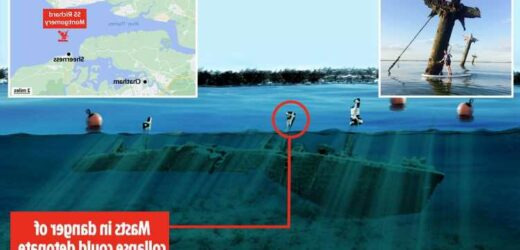THE Royal Navy will remove 1,400 tonnes of bombs from a World War Two shipwreck.
SS Richard Montgomery has been languishing at the bottom of the Thames for 77 YEARS – with fears it could explode at any moment, creating a five metre high wave that could cause “mass damage and loss of life”.
The Telegraph reports a crack team of bomb disposal experts trained in specialist underwater demolitions have now been tasked with making the 1944 wreck, on the Nore sandbank in the Thames Estuary, near Sheerness, Kent, safe.
The work is set to start in June 2022, taking two months.
The bombs – mainly for aircraft – include dozens of "high explosive Blockbuster bombs" and around 2,000 cases of cluster bombs, along with hundreds of "normal bombs" up to a weight of 1,000lbs each.
The warship was part of a US convoy travelling to the UK in August 1944- but when it arrived in the Thames Estuary, it was instructed to anchor in the Great Nore, off Sheerness, where it sank.
Specialists from the Royal Navy and 29 Explosive Ordnance Disposal Group are working with the Ministry of Defence’s (MoD) Salvage and Marine Operations on the risky mission.
The last safety survey, carried out by the Department for Transport (DfT), on the underwater wreck said if it crumbled further, it could trigger bombs on board, throwing "a 300m wide column of water and debris nearly 3,000m into the air".
The Thames "tsunami" could be as big as five metres high, and could even be deadly, experts warned.
Some 1,400 tonnes of explosives still remain on the wreck and an exclusion zone in place around it.
Most read in News
ROYAL CRISISAndrew’s lawyers ‘in emergency talks’ amid fears Maxwell could ‘name names’
Inside ‘warzone’ estate so terrifying soldier felt ‘safer in Afghanistan'
Inside Ghislaine's odd court behaviour from 'furious' sketching to posh hairdo
Seven shocking revelations from Maxwell trial including 'House of Sin' manual
Only the masts of the ship – the most surveyed and closely monitored wreck in British Waters – can be seen above the water.
The last DfT survey found the three masts were in poor condition.
Navy experts have been directed to remove them following fears one or all of them could fall and trigger an explosion of the bomb cargo.
Some of the work is thought to have been carried out in March, after Covid setbacks.
MoD documents, seen by The Telegraph, said in the worst-case scenario an explosion could be deadly – as well as causing havoc for the nearby oil and gas facilities in Sheerness.
But the Maritime and Coastguard Agency described the likelihood of a "major explosion" as "remote".
The wreck is under 24-hour radar surveillance by Medway Ports – with their operation room actually within sight of the wreck.
And high-res multibeam sonar surveys of the sunken ship are conducted on a regular basis, and have been since 2002.
The Royal Military College of Science warned in 1970 that if there was an explosion on the wreck, the force would create a 3,000 metre-high column of water and a five metre-high tidal wave that would swamp Sheerness and its 11,000 residents before travelling up the Thames.
Source: Read Full Article











